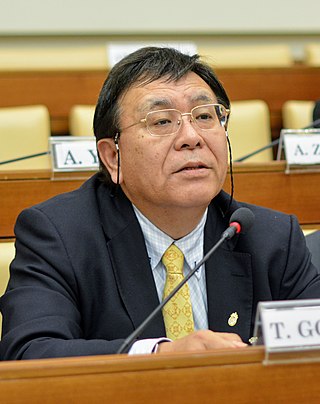Related Research Articles
Nuclear factor of activated T-cells (NFAT) is a family of transcription factors shown to be important in immune response. One or more members of the NFAT family is expressed in most cells of the immune system. NFAT is also involved in the development of cardiac, skeletal muscle, and nervous systems. NFAT was first discovered as an activator for the transcription of IL-2 in T cells but has since been found to play an important role in regulating many more body systems. NFAT transcription factors are involved in many normal body processes as well as in development of several diseases, such as inflammatory bowel diseases and several types of cancer. NFAT is also being investigated as a drug target for several different disorders.

Induced pluripotent stem cells are a type of pluripotent stem cell that can be generated directly from a somatic cell. The iPSC technology was pioneered by Shinya Yamanaka and Kazutoshi Takahashi in Kyoto, Japan, who together showed in 2006 that the introduction of four specific genes, collectively known as Yamanaka factors, encoding transcription factors could convert somatic cells into pluripotent stem cells. Shinya Yamanaka was awarded the 2012 Nobel Prize along with Sir John Gurdon "for the discovery that mature cells can be reprogrammed to become pluripotent."

Takashi Gojobori is a Japanese molecular biologist, Vice-Director of the National Institute of Genetics (NIG) and the DNA Data Bank of Japan (DDBJ) at NIG, in Mishima, Japan. Gojobori is a Distinguished Professor at King Abdullah University of Science and Technology (KAUST) in Thuwal, Saudi Arabia. He is a Professor of Bioscience and Acting Director at the Computational Bioscience Research Center at KAUST.

DNA-binding protein inhibitor ID-2 is a protein that in humans is encoded by the ID2 gene.

Protein TFG is a protein that in humans is encoded by the TFG gene.

Syntaxin-7 is a protein that in humans is encoded by the STX7 gene.

Thioredoxin-dependent peroxide reductase, mitochondrial is an enzyme that in humans is encoded by the PRDX3 gene. It is a member of the peroxiredoxin family of antioxidant enzymes.

Lysine N-methyltransferase 2C (KMT2C) also known as myeloid/lymphoid or mixed-lineage leukemia protein 3 (MLL3) is an enzyme that in humans is encoded by the KMT2C gene.

MAD2L1-binding protein is a protein that in humans is encoded by the MAD2L1BP gene.

RING finger protein 10 is a protein that in humans is encoded by the RNF10 gene.

Testis-specific serine/threonine-protein kinase 2 is an enzyme that in humans is encoded by the TSSK2 gene.

Transmembrane protein 184B is a protein that in humans is encoded by the TMEM184B gene.

NRON also known as ncRNA repressor of the nuclear factor of activated T cells is a non-coding RNA involved in repressing NFAT. The function of this ncRNA was identified by a large-scale screen of 512 non-coding RNAs discovered in earlier EST sequencing projects.
FREP is a database of mouse repeat sequences derived from cDNAs
John Quackenbush is an American computational biologist and genome scientist. He is a professor of biostatistics and computational biology and a professor of cancer biology at the Dana–Farber Cancer Institute (DFCI), as well as the director of its Center for Cancer Computational Biology (CCCB). Quackenbush also holds an appointment as a professor of computational biology and bioinformatics in the Department of Biostatistics at the Harvard School of Public Health.
RIKEN cDNA 4932414N04 is a protein that in the house mouse is encoded by the 4932414N04Rik gene. The gene is also known as RP23-459M13.1.
RIKEN cDNA 3110001I22 is a protein that in the house mouse is encoded by the 3110001I22Rik gene.
RIKEN cDNA 4933425L06 is a protein that in the house mouse is encoded by the 4933425L06Rik gene.
Julian John Thurstan Gough is a Group Leader in the Laboratory of Molecular Biology (LMB) of the Medical Research Council (MRC). He was previously a professor of bioinformatics at the University of Bristol.

FANTOM is an international research consortium first established in 2000 as part of the RIKEN research institute in Japan. The original meeting gathered international scientists from diverse backgrounds to help annotate the function of mouse cDNA clones generated by the Hayashizaki group. Since the initial FANTOM1 effort, the consortium has released multiple projects that look to understand the mechanisms governing the regulation of mammalian genomes. Their work has generated a large collection of shared data and helped advance biochemical and bioinformatic methodologies in genomics research.
References
- 1 2 "RIKEN cDNA 2010107G12" . Retrieved 2011-12-11.